Students in the UCLA/Getty Conservation Program recently dug up ancient wall paintings buried on the grounds of the Getty Villa. Not real ones, of course—it was all part of a classroom exercise for us conservators-in-training to better understand how conservation and archaeology work hand in hand.
One of the key aspects of conservation is its interdisciplinary nature. Conservators are often called on to work closely with scientists, engineers, architects, art historians, anthropologists, and especially archaeologists. Familiarity with archaeological field methods and techniques is essential to ensuring that excavations run smoothly, and that everyone is able to work together to achieve their research and preservation goals.
Recently, there has been a movement to encourage cooperative working practices and communication amongst archaeologists and conservators, as demonstrated by talks at the annual conference of the American Institute for Conservation of Historic and Artistic Works (AIC) held in Albuquerque this May.
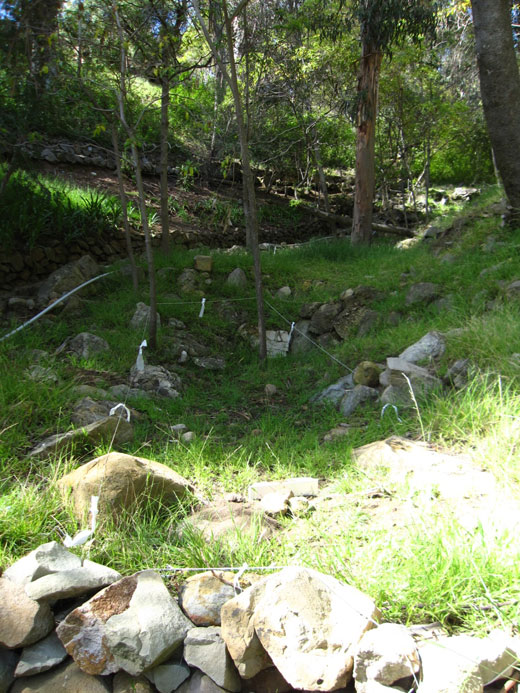
The sloped area behind the Villa Ranch House was chosen as a stand-in for an archaeological site.
That’s why the first-year students in the UCLA/Getty program participated in this excavation, held as part of Dr. Ioanna Kakoulli’s class studying the techniques and materials of archaeological and cultural materials, including both in situ and ex situ architectural surfaces (i.e., surfaces still in their natural environments, and those moved to museums or storage).
Dr. Kakoulli and Vanessa Muros, conservation specialist and laboratory supervisor for the UCLA/Getty program, buried three wall-painting replicas completed by previous students in “burial” contexts behind the Villa’s Ranch House. This was done two weeks before our excavation to give the paintings time to settle into their environment and to simulate some of the condition issues that might be confronted during a real excavation.
While many of us students have experience working at field excavations, this “dig” allowed us to better understand how and where conservation experience is necessary in the field, as well as how to interfere as little as possible with the archaeological context.

Vanessa Muros and Dr. Ioanna Kakoulli bury wall-painting replicas in preparation for the excavations.
We were incredibly lucky to have the expertise and guidance of Dr. Sarah Lepinski, a Postdoctoral fellow studying painting practices in Rome and late antique Corinth at the Getty Villa, with the assistance of Postdoctoral fellow Dr. Emma Libonati, who studies Egyptian and Hellenistic statuary, and Brett Kauffman, a doctoral candidate at UCLA’s Cotsen Institute of Archaeology, who is researching Near Eastern metallurgical technology through archaeology.
Sarah led us through basic archaeological methods, explaining their importance, then she, Emma, and Brett guided us in applying them to our own excavations, which were carried out in three teams. They reinforced that excavation is a sequential process, and that steps must be carried out and recorded in the correct order in order to reconstruct the original sequence of events.
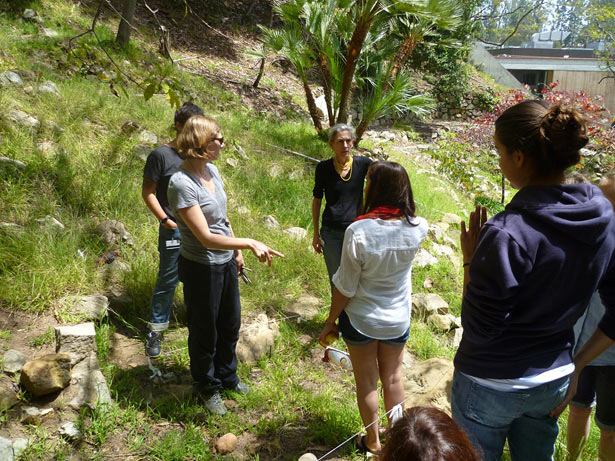
Dr. Lepinski instructs us on how to remove grass, leaves, and other material at the surface of our units.
In both conservation and archaeology, documentation is crucial. Sketches, and more recently digital photography, are often used to map out the boundaries of an area to be excavated, known as the unit. We also document the context, which includes the surrounding matrix (the physical setting, such as soil or sand) and the relative location of artifacts or features. These sketches accompany incredibly detailed notes for each unit, so that when the field notes are later processed, there is enough information to reconstruct the context and changes in stratigraphy (sequential layers of soil that represent successive periods of use).
The surrounding environment, including the vegetation, hydrology, and geology, are also considered when investigating a site. For a conservator, the context is useful for determining the possible physical and chemical changes the object has undergone in its particular environment since it was buried. For example, a moist or wet matrix promotes the movement and deposition of salts in porous building materials, such as a wall painting support, which can cause damage to both the painting surface and support structure. For this reason, good field notes are crucial to both archaeologists and conservators!
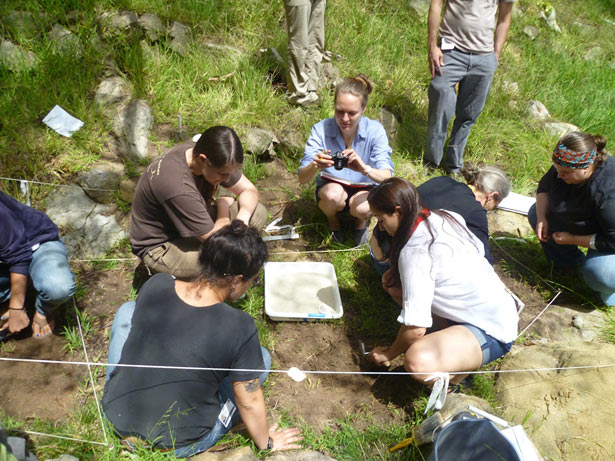
Students finish clearing off topsoil in preparation for photo-documenting buried wall-painting fragments.
The day of the exercise, we carefully removed layers of the matrix, referred to as strata, using trowels. As the topsoil is removed, a soil layer is defined by its own characteristic color, moisture, particle size, and inclusions. The sequence of changes in the strata can indicate differences in the time period that the site was occupied. Ordinarily, the depth of the layer, or its elevation, is carefully measured, but we didn’t measure depths to save time since we only had an afternoon to complete the excavation.
The measurements archaeologists take while excavating are important for determining the process by which the buried items might have been deposited. For example, if a wall painting was left as a whole in one location and elevation, on a wall even, it may be a primary deposit, meaning it was simply left by its associated culture where it was used. If there are broken pieces of the painting spread over a large space, it is possible that it is a secondary deposit, and its placement results from processes that took place long after its original deposition, such as would occur at a construction site. If archaeologists can determine its original location, this can provide many clues to the painting’s provenance. Knowing the culture that it originated from gives conservators insights into the techniques and materials used in its creation, and in turn may complement analysis used for creating a conservation treatment plan.
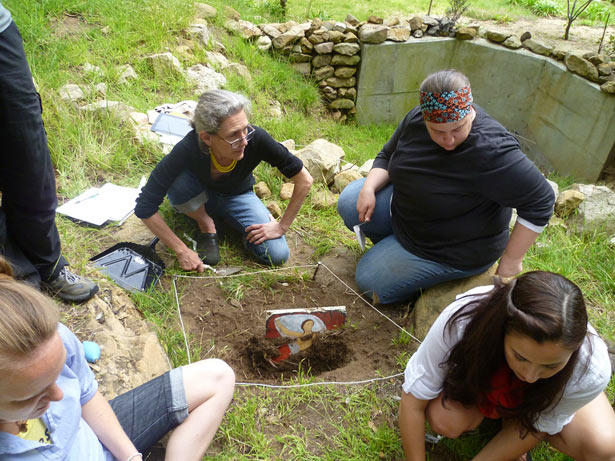
Casey Mallinckrodt and Madeleine Neiman discuss the position of a wall-painting replica and how to approach safely removing it.
We used brushes to clear some of the dirt off the surface, while excavating around the edges of the fragmented painting. One of the issues we confronted was the presence of moisture-sensitive paint layers; because the soil was moist in this particular location, great care had to be taken not to brush the paint off the surface with the moist dirt. Ultimately, all three teams decided that the paintings would have benefited most from removal by block lifting. In this technique, the artifact to be removed is left in situ, or in place, within a block of soil. Each of our blocks was lifted as a whole so that the paintings could be excavated more safely. We then moved to the lab, where we continued removing soil, studied the condition of the mural fragments, and learned how to best arrest deterioration processes resulting from burial and exposure to a new environment post-excavation.
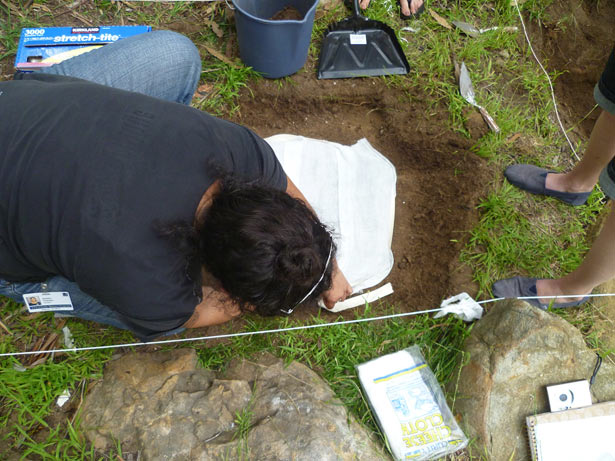
Ayesha Fuentes secures a layer of cheesecloth to the surface of a block of soil before lifting and transporting the replica to the lab.
Thank you to Drs. Lepinski, Libonati, and Kakoulli, Vanessa, and Brett for designing and implementing a wonderful experience for conservation students! We all have a better understanding of conservation in field excavations, and feel more prepared to use these skills when called upon.

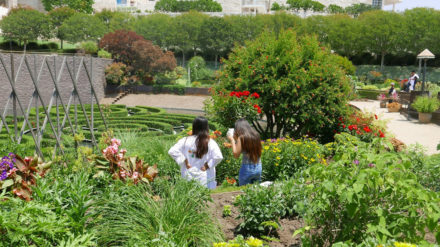
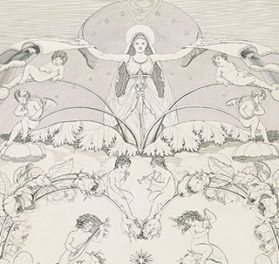

Great article Brittany! Conservators also work closely with curators (often art historians or anthropologists), exhibition staff, collections managers, and not least–communities!
Best!